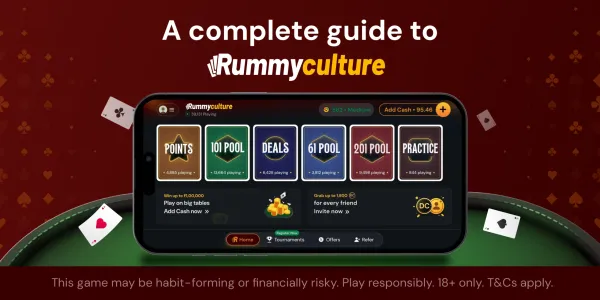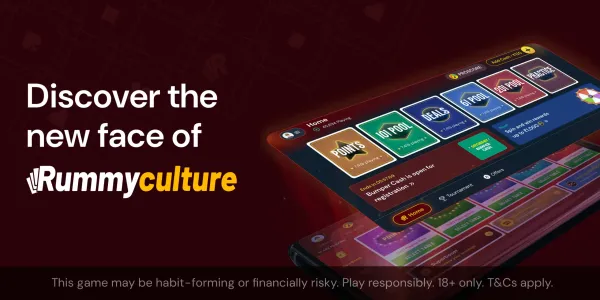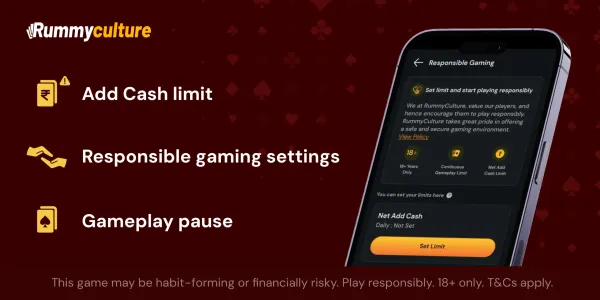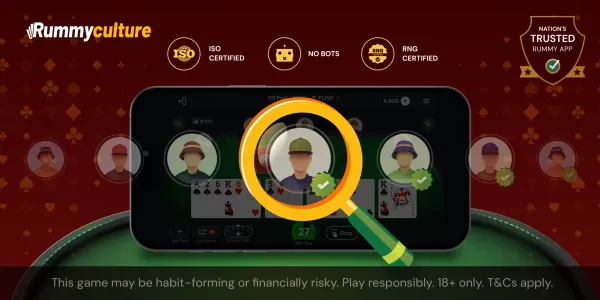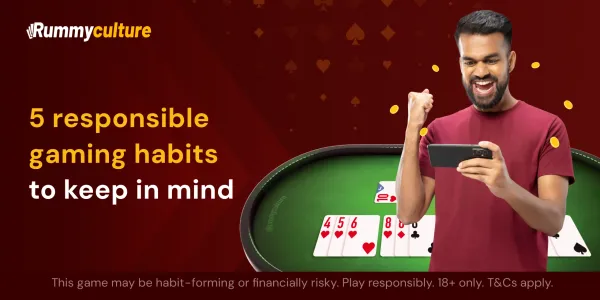- Home
- What's the Buzz
- Tash game – a beginner’s guide
Tash game – a beginner’s guide
In India, card games have been a part of households for generations. Commonly known as tash games in the country, they are usually played during festivals and family gatherings.
RummyCulture Elite Editors | 18th Jul, 2025

Tash game - a beginner's guide
In India, card games have been a part of households for generations. Commonly known as tash games in the country, they are usually played during festivals and family gatherings. Whether it’s the strategy of rummy, the excitement of Teen Patti, or the laughter that comes with Bluff, these games bring people together in a fun and memorable way.
Before we move further, we should understand exactly what a tash game is. If you’re new to the term or curious about how these games are played, this beginner’s guide is for you. In this blog we’ll discuss the basics of many tash games and how you can enjoy them online.
What is a tash game?
The name “tash” originates from the Hindi phrase “tash ke patte” which loosely translates to “playing cards”. A common saying in the Hindi-speaking belt of India is “tash khelna” which means to play cards and that is how the word “tash” has come into use in modern India. Each of these games uses a standard deck of 52 cards comprising four suits – Spades, Clubs, Diamonds, and Hearts.
Origin and history
It is believed that playing cards originated in China during the 9th century. The Tang dynasty is said to be the one which came up with this idea of playing cards. Over time, these card games began to spread across Asia and eventually reached Europe by the 11th century. As they travelled across cultures and regions, different styles and rules emerged, giving rise to the wide variety of card games we know today. In India, these games evolved into beloved pastimes, especially during festivals and family gatherings, becoming an important part of social life.
Types of tash games in India
From traditional get-togethers to modern online platforms, the love for card games remains strong. Some of the most popular tash games include rummy, known for its strategy and skill, and Teen Patti, a Diwali favorite that adds a dash of thrill to any gathering. There are also fun bluffing games like Bluff and casual picks like Donkey and Judgement. In different parts of the country, you’ll find regional variations with their own unique twists. With the rise of online gaming, many of these classics have also found new life on digital platforms, making it easier than ever to enjoy a round of tash- anytime, anywhere.
Rummy
Rummy is one of the most popular and widely played tash games in India. Players need skill, strategy, and quick thinking to play this game. The main aim of this game is to make a valid declaration first.
Objective of the Game:
To win a game of rummy, you need to be the first one to make a valid declaration. To make a valid declaration you need to have at least 2 sequences, and one of those sequences needs to be a pure sequence. The rest of the cards can be arranged into sets or sequences.
Number of Decks & Players:
Rummy is usually played with 2 to 6 players. If there are more than 2 players, two standard 52-card decks (with Jokers) are often used.
Basic Rules:
- Each player is dealt 13 cards.
- A random card is selected as the wild Joker for the round.
- Players take turns picking a card from the draw pile or discard pile, and discarding one card in return.
- The first player to form combinations and make a valid declaration wins.
Variants of Rummy:
Points Rummy: Fast-paced. Players play for points, and the one who finishes first wins based on the total value of points held by others. This is a single deal game.
Pool Rummy: Players get eliminated once they reach a points threshold. For example, if you are playing 101 Pool rummy, you will get eliminated if your points tally reaches 101.
Deals Rummy: Fixed number of deals (rounds). Players get points based on their performance in each deal, and the one with the highest total score wins.
How to Play Rummy:
Pick and discard cards to create valid sets and sequences. Keep an eye on the Jokers and the cards your opponents discard.
Winning Criteria:
Declare the game after forming at least one pure sequence and the rest as valid sets/sequences. Points are calculated based on unarranged cards in others’ hands.
Recommended Age Group:
Ages 18 and above.
Level of Difficulty:
Moderate. Easy to learn, but mastering strategy takes practice.
Where to Play Online:
Popular platforms include RummyCulture, RummyTime, and Rummyprime.
So, what are you waiting for? Start playing practice games on the RummyCulture app now.
Teen Patti
Teen Patti is a thrilling card game that also goes by the name of “Indian Poker”. The game is usually played during Diwali when family and friends get together for a good time.
Objective of the Game: Each player gets 3 cards and the aim is to have the best 3-card combo or make your opponents fold through bluffing.
Number of Decks: Teen Patti is played with one standard deck of 52 cards. No jokers are used in teen patti.
Number of Players: The game is fun when played between 3 to 6 players but more players can also participate in the game. If you have more than 6 players, it is advisable that you create 2 tables.
Rules of teen patti
- Each player is dealt three face-down cards.
- The game starts with a fixed amount known as “boot” (minimum stake).
- Players take turns betting, raising, calling, or folding, either blind (without seeing cards) or seen (after viewing cards).
- The game continues until only two players remain, leading to a showdown.
Variants
There are many exciting versions like Muflis (lowest hand wins), AK47 (A, K, 4, 7 are Jokers), Joker, and 999. Each adds its own twist to the game. You can also create your own variant if you want, for example, you can play “Imagine the third”, this means each player will get only 2 cards and they can imagine the 3rd card to be anything they want.
How to play
Players bet in a clockwise direction. Based on their confidence (or bluffing skills), they choose to continue or fold. The last remaining player or the one with the best hand at showdown wins.
Winning criteria
The strongest hand wins. Top hands include trail (three of a kind), pure sequence, and colour (same suit / flush).
Recommended age group
Since this is a game where usually stakes are involved, it’s better that people below the age of 18 do not participate in this game.
Level of difficulty
Teen patti is easy to understand but the betting and bluffing is what makes it a little bit complicated. It’s all about getting used to the game.
Poker
Probably the most popular card game in the world, poker is all about confusing your opponents through your betting style and bluffing.
Objective: The objective of this game is to win a hand either through having the best hand or making your opponents fold through bluffing.
Number of Decks:
Poker is played with one standard 52-card deck without Jokers.
Number of Players:
Typically played with 2 to 9 players at a table.
Basic Rules:
- Each player gets two cards face-down. Some variations of poker use more cards.
- They bet in rounds, based on hand strength, position, and reading opponents.
- There are 5 cards on the table kept face-down, 3 cards open after the first turn, and then 1 card gets opened after each subsequent turn. Players need to take some action on each turn.
- On their turn, players can either check, bet, or fold their hand.
- The winner is determined in a showdown or if all others fold.
Popular Variants:
- Texas Hold’em – Players get 2 private cards and use 5 community cards to make the best 5-card hand.
- Omaha – Each player gets 4 cards and must use exactly 2 of them with 3 of the 5 community cards.
- Seven Card Stud, Five Card Draw, and Pineapple are also known variants.
How to Play:
Start with blinds (forced bets), deal cards, and go through betting rounds. Players form the best hand or bluff their way to victory.
Winning Criteria:
Highest-ranking 5-card hand wins, or the last player standing after others fold.
Recommended Age Group:
18 years and above, especially when money is involved.
Level of Difficulty:
Moderate to high. It requires math, strategy, and sharp observation.
Andar Bahar
Andar Bahar is one of those tash games that is mostly based on luck. All you need to do is guess where a card will fall from the perspective of the dealer.
What is Andar Bahar?
Andar Bahar is a game of chance where players bet on whether a matching card will appear on the Andar (left) side or Bahar (right) side of the dealer.
Objective of the Game:
The goal is to correctly predict which side – Andar or Bahar – will receive a card that matches the value of the “middle card” or “joker card” placed at the start.
Number of Decks:
The game is played with one standard 52-card deck without Jokers.
Number of Players:
Usually played between a dealer and multiple players. Everyone plays against the house.
Basic Rules:
- A single card is drawn and placed face up – this is the joker card.
- The dealer then deals cards alternately to Andar and Bahar sides.
- The side that gets the matching card first is the winner.
Variants:
Some versions allow side bets on the number of cards it will take to match, or whether the matching card will appear early or late.
How to Play:
Players bet on either Andar or Bahar before the dealing begins. The game is quick and based entirely on luck.
Winning Criteria:
If the side you chose gets the matching card first, you win.
Recommended Age Group:
18+, especially for real-money games.
Level of Difficulty:
Very easy. It’s pure chance.
Satte Pe Satta
“Duki pe duki ho ya satte pe satta”, we’re sure that you have heard this song from a famous Bollywood movie at some point in your life. Satte Pe Satta is a strategic tash game played mostly in Indian households, especially during gatherings and festivals.
What is Satte Pe Satta?
The aim of the game is to get rid of all the cards from your hand before anyone else does. It’s a turn-based game that requires you to think your next move carefully.
Objective of the Game:
Be the first player to play all your cards by forming continuous sequences within each suit.
Number of Decks:
The game is played with one standard 52-card deck. For larger groups, two decks can be combined.
Number of Players:
Best played with 3 to 8 players.
Basic Rules:
- The game starts when someone places the 7 of Hearts on the table.
- Players then build upward and downward sequences in the same suit (e.g., 6, 5, 4… and 8, 9, 10…).
- The next player can only play a card that fits into the sequence.
- If no valid card is available, the player skips their turn.
Variants:
Some households start with a different 7 (like Spades), or allow Joker cards as wild cards.
How to Play:
Play moves clockwise. Players can only play cards that extend an existing sequence.
Winning Criteria:
The first player to run out of cards wins.
Recommended Age Group:
18+, especially for real-money games.
Level of Difficulty:
Easy to medium. Requires attention and planning.
Call Break
Call break, popularly known as “Lakdi” in India, is a card game where you have to win a specific number of hands.
What is Call Break?
It is a strategic game played between 4 players. At the start of the game, after looking at their cards, each player bids the number of hands they are going to win.
Objective: The objective is to win the number of hands you bid that you will win at the start of the game.
Number of Decks:
Played with one standard 52-card deck.
Number of Players:
Typically played with 4 players. Each plays individually.
Basic Rules:
- In call break, all cards of spades are trump cards.
- Each player is dealt 13 cards.
- Players look at their cards and bid the number of hands they think they can win.
- Players must follow suit if possible; if not, they can play a trump (spade) or any other card.
Scoring:
There is a scoring system involved in call break.
| Bid / Hands won | Win hands equal to the bid | Win hands lower than the bid | Points according to actual hands won | |
| Player 1 | 4 / 6 | 40 | -40 | 42 |
| Player 2 | 2 / 3 | 20 | -20 | 21 |
| Player 3 | 3 / 3 | 30 | -30 | 30 |
| Player 4 | 3 / 1 | 30 | -30 | -30 |
As you can see in the table above, player 1 bid 4 hands but won 6 of them, so they got 40 (for 4 hands) + 2 (2 extra hands) = 42 points
Player 2, bid 2 hands but won 3 of them, so they got 20 (for 2 hands) + 1 (1 extra hand) = 21 points
Player 3, bid 3 hands and won 3 of them, so they get 30 points.
Player 4, bid 3 hands but won only 1 hand, so they get a penalty equal to the number of hands that they bid = -30 points.
Variants:
Some versions allow optional Joker use or team play, but the classic version is most common.
How to Play:
Play proceeds in a clockwise direction. After all 13 tricks are played, scores are calculated based on whether players met their bids.
Winning Criteria:
The player with the highest total score after a set number of rounds wins.
Recommended Age Group:
18+, especially for real-money games.
Level of Difficulty:
Medium. Requires memory, timing, and strategic play.
3-2-5
3-2-5, also known as “Teen do paanch” is a card game played between 3 players, where one player needs to win 3 hands, the other needs to win 2 hands, and the last one needs to win 5 hands.
What is 3-2-5?
It is a three-player game where each player must win a specific number of tricks based on the game’s rotation system.
Number of Decks:
Played with one standard 52-card deck, often with only 30 cards used (removing cards 2 through 6 of each suit except the 7s of Hearts, Spades, to make 30 cards).
Number of Players:
Exactly 3 players. As one player needs to win 3 hands, one needs to win 2 hands, and one needs to win 5 hands.
Basic Rules:
The first dealer is chosen at random.
Each player is required to win 3, 2, or 5 tricks depending on the round.
The player who needs to win 5 hands chooses a trump suit and all cards of that suit become a trump card. But, the player needs to choose a trump suit only after seeing the first 5 cards they are dealt.
Variants:
Some versions rotate the target trick counts differently or allow for a fourth player using modified rules.
How to play:
In this game, players take turns playing cards, and the highest card of the led suit wins the trick. In the next round, players rotate roles so everyone plays each position.
Winning criteria:
The idea is to win the number of hands that you are required to. If you win more hands, for example, if you needed to win 2 but you end up winning 4, you get 2 random cards from another player’s group of cards in the next round.
Recommended age group:
18+, especially for real-money games.
Level of difficulty:
Easy to Medium.
Bridge
What is Bridge?
Bored of Tash games that force you to go solo? Well, Bridge is a game where you can partner with someone to play the game. It’s a game played between two teams and requires a lot of understanding between the partnering players.
Objective of the Game:
The objective is to win as many hands as possible. At the start of the game, players bid how many hands they are going to win and if they do so, they win the game.
Number of Decks:
Played with one standard 52-card deck.
Number of Players:
4 players, split into two teams (partners sit opposite each other).
Basic Rules:
The game is divided into two parts: bidding and playing.
During bidding, players declare how many tricks they think their team can win and with which suit as trump (or no trump).
In the playing phase, the highest card in the suit wins the trick, unless trumped.
Players must follow suit if possible.
Variants: Duplicate Bridge: Most common in clubs and tournaments, focuses purely on skill by using the same hands across tables.
Rubber Bridge: More casual, popular for home games.
How to Play:
After bidding, one player becomes the declarer, and their partner’s hand (the dummy) is revealed. The other two players try to stop the declarer from achieving their bid. The team that wins the number of tricks promised (or more) scores points.
Winning Criteria:
Teams score points for successful bids and can win over several hands.
Recommended Age Group:
18+, especially for real-money games.
Level of Difficulty:
High – requires focus, memory, and strategy.
Sath-Aath (7-8)
What is a 7-8 card game?
Slightly complicated but really fun when you understand it, 7-8 is a card game played between 2 players using just 30 cards. All 2s, 3s, 4s, 5s, 6s are removed along with the 7s of clubs and diamonds.
Objective: Win as many hands as you can! The player who deals the card is called the dealer while the other player is known as the caller. The caller needs to win 8 or more hands to win the game while the dealer needs to make 7 or more.
Number of Decks: Played with 30 cards only with 7 beings considered the highest ranking card, followed by Ace, King, and so on.
Number of Players:
Played between 2 players only.
Basic Rules:
- The game starts with a toss. The player with the lower card gets to be the dealer while the player with the higher card gets to be the caller.
- The dealer will then distribute 5 cards each.
- The caller then chooses the trump suit. Let’s say the caller gets K♥️J♥️10♥️8♠️9♣️, here it’s quite obvious the caller will choose hearts as the trump suit.
- Once the trump has been chosen, each player gets 5 cards face down and then 5 cards face up, kept on top of the face down cards. A player can only see the face down cards once the face up card kept on top of them has been used.
- The winner of the previous hand will always get the first turn.
How to Play:
- Shuffle the cards and start with the toss. One with the lower card gets to be the dealer.
- Both players get 5 cards and the caller chooses the trump suit.
- Then 5 cards are distributed face down and 5 cards are distributed face up.
- The caller needs to win 8 hands or more while the dealer needs to win 7 cards or more.
Recommended Age Group:
18+, especially for real-money games.
Level of Difficulty:
Easy – great for beginners and casual players.
Bluff Game
What is Bluff Game?
As the name suggests, bluff is all about confusing your opponents about your cards. Few people will know this game as “Cheat”, it is a fun card game where players try to get rid of all their cards by playing them face down and possibly lying about them. The game is a little similar to poker because here too you’re trying to guess the cards of your opponent.
Objective of the game: The objective is to discard all your cards before anyone else does. You can do this by either being honest or bluff all the way through.
Number of Decks: Usually played with one standard 52-card deck. With more players, two decks can be used.
Number of Players: Can be played with up to 6 players, if you want to use all the cards in a deck, it’s better to have an even number of players.
Basic Rules:
- Each player gets an equal number of cards. For example, if 4 are playing, each one will get 13 cards.
- On their turn, a player can place any number of cards face down and announce the cards that they have placed, for example, “2 kings”. Please note that you can only announce multiples of a single number or face cards. There can’t be “1 ace and 2 sixes”.
- The next player must place the same rank or the next in sequence and may also bluff.
- The interesting point of this game is that someone can call “Bluff” at any time of the game.
- If the player who put the last group of cards was bluffing, they pick up the entire pile. If not, the one who shouted “Bluff” picks up all the cards in the pile.
How to Play:
Players continue in turn. Use strategy to bluff without getting caught—or catch others bluffing.
Winning Criteria:
The first player to discard all cards wins.
Recommended Age Group:
18+, especially for real-money games.
Level of Difficulty:
The game is pretty easy to understand. All you need to do is master the bluffing part.
Donkey Card Game
What is Donkey Card Game?
While poker, tash, and teen patti are usually played by adults, the Donkey card game is a fun and fast-paced game often played by children. The goal of the game is simple, don’t be the “donkey” – the last one left behind holding the cards.
Objective of the Game:
The objective is to avoid being the last player left with a card. Players need to quickly form matches and get rid of their cards as fast as possible.
Number of Decks:
Played with one standard deck of 52 cards. But if more than 4 players are playing the game, you can use one more deck.
Number of Players:
3 to 6 players is ideal for this game.
Basic Rules:
- The game starts with the dealer shuffling the cards and dealing them to all the players.
- Players aim to create pairs, i.e. groups of cards of the same rank. (7,7 or 8,8, etc.).
- Once a player creates a pair, they place it face up on the table for everyone to see.
- The dealer may also call out a “Donkey,” and players must quickly grab the card that matches it to avoid getting stuck with one card.
How to Play:
- On every turn, players draw a card from the deck.
- The only way they can discard cards is by forming groups or pairs.
Winning Criteria:
It’s simple, the last person to still hold a card is known as the “donkey” and they lose the game.
Recommended Age Group:
6 years and above, as it’s simple and fun for kids and adults alike.
Level of Difficulty:
It’s a fairly easy game to play and is not complicated like poker.
Tips for beginners
While all card playing games are fun, there will be one you will fall in love with. Here are few tips to help you start with tash games:
- Start easy: Play games that are easy to understand and don’t require a lot of analysis. This will help you get used to playing card games.
- Learn the basics: Understand how a game works first and then get into the advanced techniques. Going straight for tricky moves is not the way to learn a tash game.
- Play with a familiar group: A supportive group makes learning way more enjoyable. Play with players who are patient and ready to help you learn the game.
- Observe the experienced players: Like in everything else, you can learn a lot by observing experienced players.
- Ask questions: If you hesitate, you lose out on learning. Ask as many questions that pop-up in your head while you are learning the game.
- Begin with no or low stakes: Take the pressure off and just focus on having fun because once stakes get involved, sometimes nerves kick-in and you forget the basics of the game.
- Be patient: You will not master a game in a day. Stay chill, keep playing, and you’ll get the hang of it soon!
Benefits of playing tash wala game
Playing tash games is not only fun but also helps you develop your skills in real life:
Boosts brainpower: Tash games make you think strategically and help improve your analytical skills. Since every move matters, you are bound to think of all the scenarios that might happen once you make a move.
Memory & Concentration: Tash games are a great workout for your memory. For example, in a game of rummy, you have to remember the cards being picked by your opponent to make sure that you do not discard a card that favours them.
Stress buster: Tash games are not often limited to just playing the game. There are banters and conversations happening during the game that help you relieve stress.
Legal Status of Tash Games in India
There are two types of cash games – there are few that require skills and there are a few that run purely on luck.
Game of skills vs game of chance
Rummy: It is recognised by the Supreme Court of India as a game of skill and most states in India allow rummy with stakes.
Poker: While some states recognise poker as a game of skill but some don’t. We’d advise you to check the guidelines for your state before you play poker.
It depends on your state
Every state has their own set of rules when it comes to regulating tash games. It is important you check the guidelines of your state before you start playing. However, most states allow tash games that do not involve stakes (free games).
Conclusion
Starting your tash journey? Begin with simple and easy games to get used to the pace and rules. Practice with friends or try out free online versions to build confidence.
As you play more, you’ll naturally get better at spotting patterns, building strategies, and understanding the unique styles each game offers. So shuffle those cards, deal in, and enjoy the world of tash one game at a time!
FAQs on tash games
1. What does "Tash" mean in India?
2. Are all Indian card games played with a standard 52-card deck?
3. Which is the easiest tash game to learn for a beginner?
- Rummy: With a focus on forming valid sets and sequences, rummy is both logical and engaging once you understand the basics.
- Teen patti: Simple rules and poker-style gameplay make it fun and easy to learn.
4. Is playing tash games legal in India?
- Games of skill (like rummy) are generally legal and protected under the law. However, some states do not allow rummy games that have stakes involved.
- Games of chance (like many gambling-style games) are more restricted. Teen patti can be considered a game of chance.
5. Are there online versions of these tash games?
Featured articles


